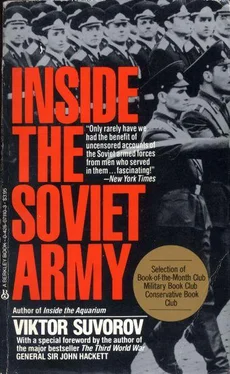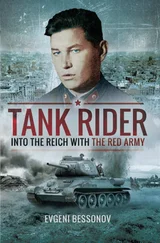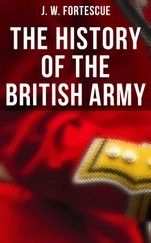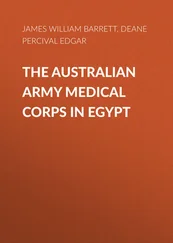Here is one entirely typical example of such a breakthrough, carried out by the 16th Guards Rifle Corps of the 2nd Guards Army at Kursk in 1943. During an offensive by nine forward battalions only one managed to make any ground. Immediately, the commander of the regiment to which this battalion belonged concentrated all his resources at that point, on a front one kilometre wide. His divisional commander thereupon threw all his forces into this sector. The breach slowly became deeper and wider and within half an hour the corps commander's reserves began to arrive. Within three hours, 27 of the 36 battalions belonging to the corps had been brought in to fight in the narrow sector, which was by now 7 kilometres wide. 1,087 of the 1,176 guns belonging to the corps, and all its tanks, were assembled in the breakthrough sector. Naturally, the battalion commanders who had been unable to penetrate the enemy's defences not only received no reinforcements, but had everything under their command taken away from them. And this was entirely as it should have been!
As the breach was widened, more and more forces were concentrated there. As soon as he was informed of the breakthrough the Commander of the Central Front, General Rokossovskiy, rushed an entire Army to the spot, with an Air Army to cover the operations. A few days later the Supreme Commander added his own reserve army, the 4th Tank Army, to the forces breaking through. Such a massive concentration of forces could not, of course, be withstood by the German commanders. Several hundred kilometres of their front disintegrated simultaneously and a hasty withdrawal began. The last big offensive mounted by the German army in World War II had collapsed. After this, the Germans never again launched a single large-scale attack, confining themselves to smaller operations, such as those at Balaton or in the Ardennes. The moral of this story is clear. If every platoon commander had had the right to call for fire support for his unit, the corps commander would have been unable to concentrate his reserves in the breach and the Front would never have broken through. Without this, there could have been no success.
4
Modern Soviet tactics, then, follow in the footprints of Jenghiz Khan, Bonaparte, the German generals who won the battle for France and the Soviet generals in the war against Germany.
Nuclear weapons have changed the face of war, as did artillery in the middle ages, the machine gun in the First World War and the tank in the Second. The principles of military science have not been affected by these changes, for they are immutable-disperse your forces and you will lose, concentrate them and you will win.
The only amendment which needs to be made to these ancient principles in the nuclear age is that a commander must concentrate his nuclear forces, too, in the main sector, together with the artillery, aircraft, and tanks which he assembles there. The threat of a nuclear response, too, plays a role in tactics. The concentration of forces can be completed very rapidly today, and they are then a target for the enemy's nuclear weapons, whereas earlier he was unable to use them during the comparatively long time they took to assemble. Otherwise everything remains as it was. If a single company breaks through the battalion commander supports it with his whole mortar battery, leaving the other companies to fend for themselves. Informed of the success of the company, the commander of the regiment orders his tank battalions to the sector and arranges for his artillery to provide concentrated fire support, then the divisional commander moves in his tank regiment and he too brings in his entire artillery reserves; in addition, he may arrange to have nuclear strikes carried out ahead of his troops. Then, flooding through like the torrent, rushing through the broken dam, come all the tanks and artillery of the Army, all the tanks, aircraft, artillery and rockets of the Front, of the Strategic Direction, of the Soviet Union and of its satellites!
5
One further misunderstanding needs clarification. Although a platoon or company commander is not entitled to summon up aircraft or the divisional artillery, this certainly does not mean that Soviet forces operate without fire support. The commander of a Soviet motor-rifle battalion (400 men) has 6 120mm mortars at his disposal. The commander of an American battalion (900 men) has only 4 106mm mortars. The commander of a Soviet regiment (2,100 men) has a battalion of 18 122mm howitzers and a battery of 6 Grad P multi-barrelled rocket launchers. The commander of an American brigade (4,000–5,000 men) has no fire weapons at all. Commanders of Soviet and American divisions have approximately the same quantity of fire weapons.
Commanders of Soviet battalions and regiments, not being entitled to call on their divisional commanders for help have enough fire weapons under their command to follow up successes achieved by any of their platoons, companies or battalions. Since they are equipped with these weapons, the divisional commander is free to make use of the full weight of his divisional artillery wherever he decides it is needed.
1
Many Western specialists believe that in order to carry out an operation of the sort described it would be necessary to assemble a massive concentration of material resources and that the Soviet command would encounter extreme difficulty in providing its enormous forces with the supplies they would need. This delusion is based on typical Western concepts of the organisation of the supply and replenishment of military forces.
The Soviet Army has a completely different approach to the problems of supply from that adopted in the West-one which avoids many headaches. Let us start from the fact that a Soviet soldier is not issued with a sleeping bag, and does not need one. He can be left unfed for several days. All that he needs is ammunition and this solves many problems. The problem of supplying Soviet troops in battle is thus confined to the provision of ammunition. We already know that each commander has transport sub-units at his disposal; every regiment has a company which can transport loads of 200 tons, every division a battalion with a capacity of 1,000 tons, every Army a transport regiment, and so forth. All this capacity is used solely to move up ammunition for advancing forces. Each commander allocates a large proportion of this ammunition to the sector which is achieving success-the remainder suffer accordingly.
No less important during a rapid advance is fuel-the life-blood of war. A basic approach has been taken to the problem of fuel-supply. As a condition for its acceptance by the armed Services, every type of Soviet combat vehicle-tanks, armoured personnel carriers, artillery prime movers, etc.-must have sufficient fuel capacity to take it at least 600 kilometres. Thus, Soviet Fronts would be able to make a dash across Western Germany without refuelling. Thereafter, the pipe-laying battalion of each Army would lay a line to the Front's main pipeline which would have been laid by the Front's pipe-laying regiment. The Front's pipelines would be linked with secret underground main lines which had been laid down in Eastern Europe in peacetime. In addition, the C-in-C of a Strategic Direction has under his command a pipe-laying brigade, which can be used to assist the Fronts. At the terminals of the pipelines the pipe-layers set up a number of refuelling centres, each of which can simultaneously refuel a battalion or even a regiment. In addition, the Soviet Army is at present evolving techniques for using helicopters for fuel resupply. Let us take a division which is advancing. One of its tank battalions has stopped, on orders from the divisional commander, and is left behind by the other battalions. In a field by the road, on which the battalion has halted, a V-12 helicopter lands, carrying 40 or more tons of fuel. Within ten minutes it has refuelled all the tanks and taken off again. The battalion sets off for the front again, replacing another which halts to refuel. A single V-12 helicopter flying at low altitude at a speed of 250 kilometres an hour, can refuel a whole division in one day. It is not particularly vulnerable, since it is flying over its own rear areas, which are protected by the Air Defence Troops of the Land Forces. If trucks were used to supply a division hundreds of them would be needed, travelling on damaged, overloaded roads and presenting an excellent target. The destruction of a single bridge could bring them all to a halt. While a single truck carrying ten tons would take twenty-four hours to make a particular journey, a helicopter could do the same job in one hour. Even if helicopters were more vulnerable than endless convoys of trucks, Soviet generals would still use them, for time is far more precious than money during a war.
Читать дальше












